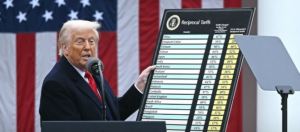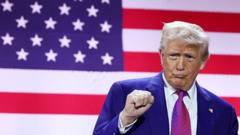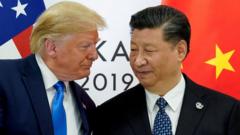The unveiling of a 10% universal tariff and specific higher tariffs on China and other countries signals a bold shift in U.S. trade policy, prompting concerns over economic retaliation and market volatility.
Trump's Tariff Strategy Reshapes Global Trade Dynamics

Trump's Tariff Strategy Reshapes Global Trade Dynamics
President Trump's new tariffs, starting April 9, 2025, introduce a universal 10% levy on imports and reciprocate against countries with high trade barriers.
April 9, 2025, marks a pivotal moment in U.S. trade policy as President Donald Trump officially implements an aggressive new tariff strategy aimed at redefining global trade relations. Coined "Liberation Day" by the administration, this initiative introduces a universal 10% tariff on all foreign imports, alongside additional tariffs on nations with strict trade barriers against American exports.
The focal point of these tariffs is China, which now faces a staggering 54% tariff on its imports to the United States. This includes a hefty 34% reciprocal duty imposed directly atop an existing 20% tariff. Treasury Secretary Scott Bessent has confirmed that this aggressive move is a reaction to China's enduring protectionist measures and allegations of intellectual property theft.
Other major global players are also feeling the impact, facing notable tariff increases: the European Union will incur a 20% rise, Japan will see a 24% hike, South Korea faces a 25% surge, Vietnam's tariffs are set at 46%, and Taiwan's tariffs will increase by 32%. The rollout of the initial 10% tariff began on April 5, while the country-specific tariffs became effective on April 9.
Trump has pitched this sweeping trade strategy as vital for safeguarding American industries and rectifying longstanding issues with trade agreements. "We’re not starting a trade war," he asserts, emphasizing the need to end what he views as an unfair trade struggle imposed upon the U.S. for years.
However, opponents of the new tariffs have expressed deep concern that these measures could inflate product prices for American consumers and trigger retaliatory actions from affected nations. This fear quickly became reality as China announced countermeasures, including heightened tariffs on U.S. goods and export limitations on essential rare earth minerals crucial for American manufacturing and defense resources.
Market reactions have been volatile, as investors grapple with the consequences of a potential long-term trade impasse. Analysts globally warn that this shift in U.S. trade policy could fundamentally alter the international economic landscape if other nations decide to adopt similar approaches.
Despite the backlash, the Trump administration maintains that these tariffs represent merely the initial step in a larger initiative aimed at reviving American manufacturing, penalizing unfair trading partners, and reclaiming U.S. economic supremacy on the world stage.
The focal point of these tariffs is China, which now faces a staggering 54% tariff on its imports to the United States. This includes a hefty 34% reciprocal duty imposed directly atop an existing 20% tariff. Treasury Secretary Scott Bessent has confirmed that this aggressive move is a reaction to China's enduring protectionist measures and allegations of intellectual property theft.
Other major global players are also feeling the impact, facing notable tariff increases: the European Union will incur a 20% rise, Japan will see a 24% hike, South Korea faces a 25% surge, Vietnam's tariffs are set at 46%, and Taiwan's tariffs will increase by 32%. The rollout of the initial 10% tariff began on April 5, while the country-specific tariffs became effective on April 9.
Trump has pitched this sweeping trade strategy as vital for safeguarding American industries and rectifying longstanding issues with trade agreements. "We’re not starting a trade war," he asserts, emphasizing the need to end what he views as an unfair trade struggle imposed upon the U.S. for years.
However, opponents of the new tariffs have expressed deep concern that these measures could inflate product prices for American consumers and trigger retaliatory actions from affected nations. This fear quickly became reality as China announced countermeasures, including heightened tariffs on U.S. goods and export limitations on essential rare earth minerals crucial for American manufacturing and defense resources.
Market reactions have been volatile, as investors grapple with the consequences of a potential long-term trade impasse. Analysts globally warn that this shift in U.S. trade policy could fundamentally alter the international economic landscape if other nations decide to adopt similar approaches.
Despite the backlash, the Trump administration maintains that these tariffs represent merely the initial step in a larger initiative aimed at reviving American manufacturing, penalizing unfair trading partners, and reclaiming U.S. economic supremacy on the world stage.





















